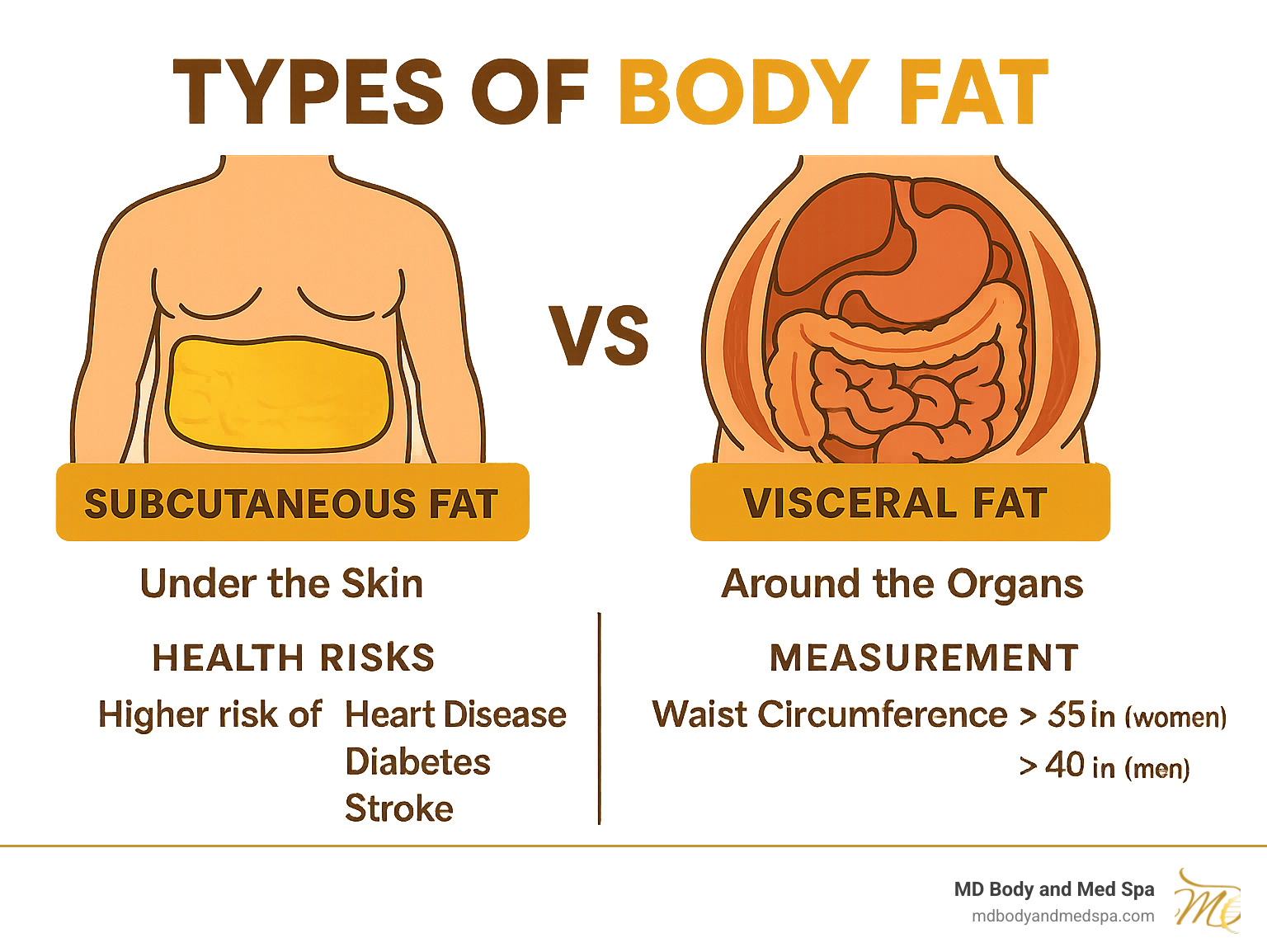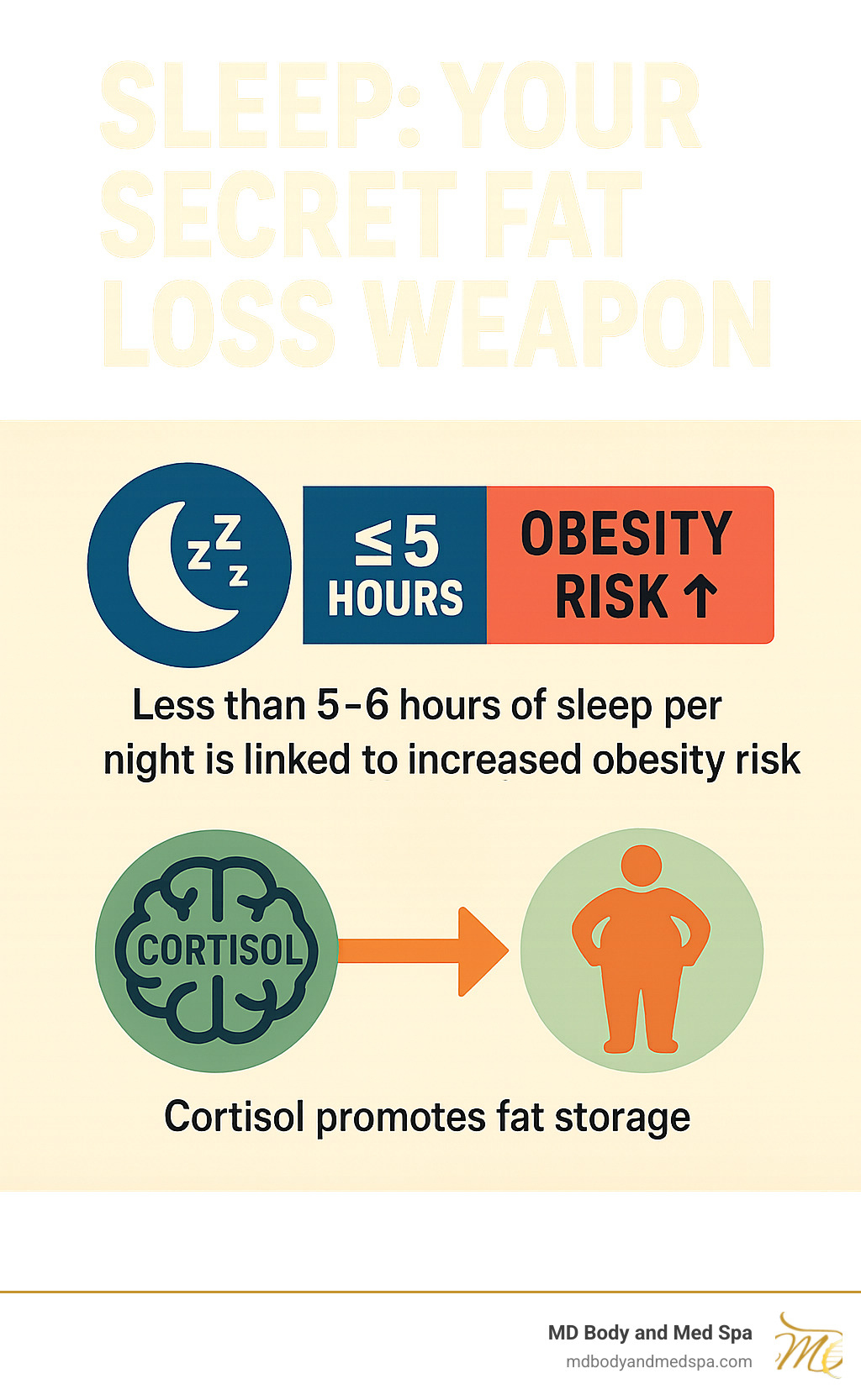Trim the Fat: Proven Strategies to Lose Body Fat
Why Understanding Body Fat Is the First Step to Real Results

Learning how to get rid of body fat starts with understanding what you're actually fighting against. Body fat isn't just one thing - it's a complex system that affects your health, appearance, and confidence.
Quick Answer: How to Get Rid of Body Fat
- Create a calorie deficit through diet and exercise
- Eat more protein (aim for 0.8-1g per pound of body weight)
- Do strength training 2-3 times per week to preserve muscle
- Add cardio for 150-300 minutes weekly
- Get 7-9 hours of sleep to regulate hunger hormones
- Manage stress to control cortisol levels
- Stay consistent - aim for 1-2 pounds of fat loss per week
There are two main types of body fat you need to know about. Subcutaneous fat sits just under your skin - this is what you can pinch. Visceral fat wraps around your internal organs and poses the biggest health risks.
Visceral fat makes up about 10% of your total body fat, but it's responsible for most serious health problems. A waist measurement over 35 inches for women or 40 inches for men signals dangerous levels of this "toxic" fat.
The good news? Visceral fat responds quickly to the right strategies. Studies prove that losing just 1-2 pounds per week through proven methods can dramatically reduce both types of fat while preserving your muscle mass.
I'm Rachel Stone, CEO of MD Body and Med Spa, and I've spent over a decade helping clients understand how to get rid of body fat through both holistic health approaches and advanced medical aesthetics.

Why Body Fat Matters: Types, Risks & How to Measure
Think of your body fat as having two very different personalities. Subcutaneous fat - the squishy layer you can pinch under your skin - might make your jeans feel tight, but it's actually pretty harmless. Visceral fat, on the other hand, is the troublemaker hiding deep in your belly.
Visceral fat doesn't just sit there quietly. Instead, it acts like a hormone factory gone rogue, pumping out inflammatory chemicals that mess with your entire body. This deep belly fat wraps around your liver, pancreas, and other vital organs, creating chaos from the inside out.
The health risks are real and scary. Research from Harvard Medical School shows that every 2 inches of extra waist size bumps up your heart disease risk by 10%. Women with waist measurements over 35 inches face a 37% higher risk of asthma. Men with waists over 40 inches are in the danger zone too.
But here's the silver lining - visceral fat actually responds faster to how to get rid of body fat strategies than the stubborn subcutaneous stuff. You can see real improvements in just 2-3 months of consistent effort.
Measuring your progress accurately is crucial for staying motivated. Your bathroom scale won't tell you the whole story, so try these methods instead:
Waist circumference gives you the most important number. Grab a tape measure and wrap it around your bare stomach, right above your hip bones. Keep it snug but not tight, breathe out normally, and record that number. For women, anything over 35 inches signals high risk. For men, it's 40 inches.
Waist-to-height ratio is even more telling. Just divide your waist measurement by your height in inches. If you get 0.5 or higher, it's time to take action.
BMI calculations can give you a baseline, but don't rely on them completely. A muscular person might have a high BMI but very little body fat. That's why combining BMI with waist measurements gives you a clearer picture.
For the most accurate results, a DEXA scan shows exactly where your fat and muscle are distributed throughout your body.
Scientific Perspective
Scientific research on visceral fat reveals just how metabolically active this deep belly fat really is. Unlike the relatively quiet subcutaneous fat, visceral fat produces cytokines that trigger inflammation throughout your body. It also creates precursors to angiotensin, a compound that raises your blood pressure.
This constant inflammatory state puts you at higher risk for metabolic syndrome - a cluster of conditions including high blood sugar, liftd blood pressure, and abnormal cholesterol levels. Left unchecked, metabolic syndrome often leads to type 2 diabetes, heart disease, and stroke.
The encouraging news from research is that visceral fat melts away more readily than subcutaneous fat when you make the right lifestyle changes. Studies consistently show measurable reductions in dangerous belly fat within 2-3 months of following proven strategies.
Nutrition Game Plan: How to Get Rid of Body Fat With Food
Fat loss starts in the kitchen — about 70% of your results come from what you eat. This isn’t about starving yourself or banning entire food groups. It’s about eating strategically so your hormones, metabolism, and hunger cues work for you.
Create a sustainable calorie deficit. Aim to eat 250-500 fewer calories than you burn each day. Moderate deficits protect energy, mood, and metabolism while delivering steady results.
Prioritize protein. About 0.8-1 g per pound of body weight preserves muscle and slightly boosts metabolism. Lean meats, fish, eggs, dairy, and legumes also keep you fuller longer.
Choose smart carbs. Whole-grain, high-fiber carbohydrates are linked to lower BMI and less belly fat. Trade white bread or rice for quinoa, oats, or brown rice.
Include healthy fats. Reasonable portions of olive oil, nuts, and avocado support fat loss and heart health. Diets rich in monounsaturated fats (think Mediterranean style) routinely outperform strict low-fat plans.
Leverage fiber. Soluble fiber slows digestion and curbs appetite; an extra 10 g a day can significantly cut abdominal-fat gain. Pile your plate with vegetables, fruits, beans, and oats.
Portion Control & Meal Timing: how to get rid of body fat daily
The plate method keeps portions simple: half vegetables, one-quarter lean protein, one-quarter complex carbs.
Intermittent fasting (such as 16/8) naturally limits calories and can drop up to 7% of body weight in 3-12 weeks by improving insulin sensitivity.
Meal prep curbs impulsive choices. People who prepare meals in advance eat more produce and fewer convenience foods.
Gut Health & Fat Loss
Your gut microbiome affects how many calories you absorb and where you store them.
- Probiotics: Strains like Lactobacillus fermentum, L. amylovorus, and L. gasseri have documented belly-fat benefits.
- Prebiotics: Garlic, onions, asparagus, and artichokes feed good bacteria.
- Fiber diversity: Shoot for 25–30 different plant foods per week to maximize microbial variety and improve insulin sensitivity, inflammation, and appetite control — all of which make how to get rid of body fat far easier.
Move More, Burn More: Exercise Strategies to Reduce Body Fat
Here's the truth about exercise and fat loss: it's not just about sweating buckets during your workout. The real magic happens when you create lasting metabolic changes that help your body burn fat around the clock.
Strength training is absolutely non-negotiable if you're serious about how to get rid of body fat effectively. Research proves that resistance training for just four weeks can decrease body fat by an average of 1.46%. But here's the kicker - it preserves your precious muscle mass during weight loss, which keeps your metabolism humming at a higher rate.
Compound movements are your best friends because they work multiple muscle groups at once, giving you more bang for your buck. Squats and deadlifts target your entire lower body and core. Push-ups and pull-ups challenge your upper body strength. Rows and overhead presses build functional power. Planks and mountain climbers fire up your core while boosting your heart rate.
Cardiovascular exercise needs to be part of your weekly routine too. Aim for 150-300 minutes of moderate-intensity cardio each week. The 150-minute minimum gives you solid health benefits, while pushing toward 300 minutes maximizes your fat loss potential.
High-intensity interval training (HIIT) is like the espresso shot of cardio - concentrated and powerful. You can burn up to 30% more calories than steady-state cardio in the same amount of time. A simple HIIT session might look like 30 seconds of all-out effort followed by 60 seconds of recovery, repeated 10-15 times.
Don't forget about NEAT (Non-Exercise Activity Thermogenesis) - basically all the movement you do that isn't formal exercise. Taking stairs instead of elevators, parking farther away, even fidgeting at your desk can significantly boost your daily calorie burn.
Workout Blueprint: how to get rid of body fat efficiently

Let me share a weekly structure that my clients find both manageable and incredibly effective for fat loss.
Monday and Thursday become your strength days with 45-minute full-body sessions. Focus on compound movements with progressive overload - gradually increasing weight, reps, or intensity over time. Aim for 3 sets of 8-12 reps to build muscle, and rest 60-90 seconds between sets to maintain intensity.
Tuesday and Friday are for HIIT cardio sessions lasting just 20-30 minutes. Start with a 5-minute warm-up, dive into 15-20 minutes of intervals, then cool down for 5 minutes.
Wednesday calls for steady-state cardio for 30-45 minutes at moderate intensity. You should be able to hold a conversation while exercising. Walking, cycling, swimming, or dancing all work beautifully here.
Weekends are for active recovery - think yoga, hiking, recreational sports, or long walks. Your body needs time to repair and rebuild, but staying gently active keeps you feeling energized.
Strength vs Cardio – What Burns More?
| Exercise Type | Calories During | Calories After | Muscle Preservation | Fat Loss Efficiency |
|---|---|---|---|---|
| Strength Training | Moderate | High (24-48 hours) | Excellent | High |
| HIIT Cardio | High | Moderate (6-24 hours) | Good | Very High |
| Steady Cardio | Moderate-High | Low | Fair | Moderate |
The winner isn't one or the other - it's the combination. Strength training provides the metabolic boost and muscle preservation your body craves, while cardio maximizes calorie burn during exercise. HIIT gives you the best of both worlds in less time.
The "afterburn effect" from strength training can keep your metabolism liftd for up to 48 hours after your workout. That means you're literally burning more calories while sitting at your desk the next day.
Lifestyle Levers: Sleep, Stress, Tracking & Patience
Here's where most people get tripped up when learning how to get rid of body fat: they focus so hard on diet and exercise that they ignore the lifestyle factors that can make or break their results. I've seen clients do everything "right" with their workouts and meals, only to plateau because they're getting four hours of sleep and stressed to the max.
Sleep is your secret fat-loss weapon. When you consistently get fewer than 5-6 hours per night, your body fights against fat loss. Your hunger hormones go haywire, making you crave exactly the foods that sabotage your progress. Your metabolism slows down. Even your willpower takes a hit.
Poor sleep disrupts ghrelin (your hunger hormone) and leptin (which tells you when you're full). This hormonal chaos makes it nearly impossible to stick to healthy eating habits, no matter how motivated you are.
Creating better sleep happens with small, consistent changes. Keep a regular bedtime even on weekends - your body craves routine. Make your bedroom cool and dark because even small amounts of light can disrupt sleep quality. Put away screens an hour before bed because that blue light tricks your brain into thinking it's daytime. And cut off caffeine after 2 PM since it can stay in your system for 6-8 hours.
Stress management isn't optional if you're serious about fat loss. Chronic stress floods your system with cortisol, which directly promotes fat storage around your midsection. It's like your body is constantly preparing for famine, holding onto every calorie it can get.
People who combine stress-management techniques with calorie restriction lose significantly more weight than those who just focus on diet. Daily meditation - even just 10 minutes - can lower cortisol levels. Regular yoga practice combines movement with stress relief. Deep breathing exercises activate your parasympathetic nervous system, telling your body it's safe to let go of stored fat.
Tracking creates accountability like nothing else can. Studies consistently show that people who monitor their progress lose twice as much weight as those who wing it. You don't need to become obsessive, but paying attention to your daily calorie intake, step count, sleep quality, and weekly measurements gives you real data to work with.
The beauty of tracking is that it removes guesswork. When progress stalls, you can look at your data and see exactly what needs adjusting instead of wondering what went wrong.
Patience might be the hardest part of learning how to get rid of body fat effectively. We live in a world of instant everything, but sustainable fat loss happens at 1-2 pounds per week. This rate preserves your muscle mass and creates lasting habits instead of temporary changes.
Faster loss almost always means you're losing muscle along with fat, which slows your metabolism and makes it harder to maintain your results. The tortoise really does win this race.
Scientific research on sleep & obesity confirms that sleep quality directly impacts your body's ability to regulate weight through complex hormonal pathways. When you prioritize sleep, stress management, and consistent tracking, you're giving yourself every advantage in this process.

Beyond DIY: Non-Surgical Help & When to Seek Pros

Let's be honest - sometimes your body just doesn't cooperate. You've been eating right, exercising consistently, and getting enough sleep, but those stubborn fat pockets refuse to budge. This is where professional help can bridge the gap between your hard work and your goals.
I see this all the time at MD Body and Med Spa. Clients come to us feeling frustrated because they've done everything "right" but still can't achieve the results they want. The truth is, how to get rid of body fat isn't always straightforward, especially when genetics, hormones, or medical conditions are working against you.
Plateaus happen to everyone. Your body is incredibly smart at adapting to changes, which means your initial fat loss strategies may stop working after a few months. This doesn't mean you're doing anything wrong - it just means you need to adjust your approach or get additional support.
Medical conditions can complicate fat loss in ways that feel incredibly unfair. Hypothyroidism, insulin resistance, PCOS, and other hormonal imbalances can make losing fat feel like pushing a boulder uphill. If you suspect underlying health issues, working with professionals who understand these complexities becomes essential.
Hormonal changes, particularly during menopause, can completely shift where your body stores fat and how easily it comes off. The strategies that worked in your 20s and 30s might not be as effective in your 40s and beyond. This isn't a personal failing - it's biology.
At MD Body and Med Spa in Greenwood Village, we've built our approach around understanding these real-world challenges. Our Body Sculpting treatments aren't meant to replace healthy habits - they're designed to work alongside them.
CoolSculpting uses controlled cooling to freeze fat cells, which your body then naturally eliminates over the following months. Laser fat reduction targets stubborn areas with precise energy that breaks down fat cells without damaging surrounding tissue. Radiofrequency treatments not only reduce fat but also tighten skin, addressing two concerns at once.
What I love about our Fat Reduction services is that they're not magic bullets - they're strategic tools. The clients who see the best results are those who combine these treatments with the nutrition and exercise principles we've discussed throughout this guide.
Medical weight loss programs represent another level of support for those with significant weight to lose. Medications like Semaglutide, when used under medical supervision, can help reduce body weight by 15-25% when combined with lifestyle changes. These aren't shortcuts - they're medical tools that address the hormonal and neurological factors that make sustained weight loss so challenging.
The key is knowing when to seek help and choosing professionals who view these treatments as part of a comprehensive approach to health, not standalone solutions.
Frequently Asked Questions about Body-Fat Reduction
Let me address the most common questions I hear from clients who are serious about learning how to get rid of body fat. These are the real concerns that keep people up at night, wondering if they're doing everything right.
What's the safest weekly rate to lose fat?
Here's the truth that might surprise you: slower is actually faster when it comes to lasting results. The safest and most sustainable rate is 1-2 pounds per week, and there's solid science behind this recommendation.
When you lose weight too quickly, your body panics. It thinks you're starving, so it slows down your metabolism and starts breaking down muscle tissue for energy. This is the opposite of what we want when learning how to get rid of body fat effectively.
That 1-2 pound weekly loss allows your body to adapt gradually. Your metabolism stays strong, your muscle mass is preserved, and you're building habits that will actually stick. I've seen too many clients crash diet their way to quick losses, only to regain everything plus extra weight within months.
Can I spot-reduce belly fat with crunches?
I wish I could tell you yes, but spot reduction is one of the biggest myths in fitness. Doing a thousand crunches won't magically melt away belly fat, no matter how much we want it to work that way.
Crunches will absolutely strengthen your abdominal muscles underneath the fat layer. But fat loss happens systemically throughout your entire body based on your genetics, hormones, and overall calorie balance.
Think of it this way - when you put on weight, did you get to choose exactly where it went? Of course not. The same principle applies when losing it. Your body has its own blueprint for where it stores and releases fat, and we can't override that with targeted exercises.
The good news is that the strategies we've covered - creating a calorie deficit, strength training, cardio, and proper nutrition - will reduce fat everywhere, including that stubborn belly area.
Does intermittent fasting work for everyone?
Intermittent fasting has gotten a lot of buzz lately, and while it can be effective, it's not a magic solution that works for everyone. Let me break down when it helps and when it doesn't.
Intermittent fasting primarily works by naturally reducing your calorie intake and improving insulin sensitivity. When you limit your eating window, many people naturally eat fewer calories without having to count them obsessively.
But intermittent fasting may not be suitable if you're pregnant or breastfeeding, have a history of eating disorders, or certain medical conditions like diabetes. Some people also find it makes them irritable, affects their sleep, or leads to overeating during their eating windows.
The most important factor in learning how to get rid of body fat isn't the specific timing of your meals - it's finding an eating pattern you can maintain long-term while creating a sustainable calorie deficit.
Conclusion & Next Steps
Your journey to learning how to get rid of body fat doesn't end here - it's just beginning. The strategies we've explored together aren't just theories from textbooks. They're battle-tested methods that work when you apply them consistently and give yourself the grace to learn along the way.
Think of fat loss like learning to drive. At first, everything feels overwhelming, but with practice, it becomes second nature. The same applies to creating a sustainable calorie deficit through smart food choices, building strength to preserve your muscle and rev up your metabolism, and incorporating cardio that you actually enjoy.
The lifestyle pieces matter just as much. Quality sleep isn't a luxury - it's your secret weapon against stubborn fat. Managing stress keeps cortisol from working against you. Tracking your progress helps you see patterns and celebrate wins you might otherwise miss.
Here's what I want you to remember: sustainable fat loss really is a marathon, not a sprint. There will be weeks when the scale doesn't budge, days when motivation feels low, and moments when you question if it's worth it. That's completely normal and part of the process.
At MD Body and Med Spa, we've seen thousands of clients steer these exact challenges. Our team understands that everyone's path looks different. Some clients thrive with nutrition coaching and lifestyle changes alone. Others benefit from our advanced body contouring technologies when they hit those stubborn plateaus.
What makes us different is our approach. We're not just about the latest treatments - though our cutting-edge techniques certainly help. We're about understanding your unique situation and creating a plan that fits your life, your goals, and your timeline.
Whether you're taking your first steps toward better health or you've been working at this for months, professional support can make all the difference. Sometimes you need someone in your corner who understands the science, has seen what works, and can adjust your approach when life throws curveballs.
Ready to move forward with confidence? We're here to support you every step of the way. From personalized consultations to advanced treatments that complement your healthy lifestyle, we have the tools and expertise to help you succeed.
Your future self is counting on the decisions you make today. You have everything you need to succeed - the knowledge, the strategies, and now the support system. The only question left is: are you ready to start?
